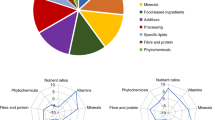Abstract
Public health and regulatory assessments and guidance on sugars increasingly focus on free (rather than total or added) sugars in the diet. This emphasizes differentiation between sugars consumed within versus outside of an intact plant matrix. However, there is no analytical method for free sugars, and quantitative determination in heterogenous and processed products containing mixed sizes of plant particulates as ingredients (e.g., soups or chopped and cooked foods) is particularly problematic for nutrition declarations and monitoring. The method suggested here is based on sieving, with the particle size threshold derived from data on the typical end-products of mastication. This simple method could generate an objective, quantitative estimate of free sugars that logically corresponds to the free sugars concept in public health. It has the potential to be applied to many product types, and is proposed as a possible standard method for empirical testing and possible wider validation and endorsement.
This is a preview of subscription content, access via your institution
Access options
Subscribe to this journal
Receive 12 print issues and online access
$259.00 per year
only $21.58 per issue
Buy this article
- Purchase on Springer Link
- Instant access to full article PDF
Prices may be subject to local taxes which are calculated during checkout
Similar content being viewed by others
References
Mela DJ, Woolner EM. Perspective: total, added, or free? What kind of sugars should we be talking about? Adv Nutr. 2018;9:63–9.
World Health Organization. Guideline: sugars intake for adults and children. (World Health Organization, Geneva, 2015).
Swan GE, Powell NA, Knowles BL, Bush MT, Levy LB. A definition of free sugars for the UK. Public Health Nutr. 2018;21:1636–8.
Amoutzopoulos B, Steer T, Roberts C, Cole D, Collins D, Yu D, et al. A disaggregation methodology to estimate intake of added sugars and free sugars: an illustration from the UK National Diet and Nutrition Survey. Nutrients. 2018;10:1177.
Peyron M-A, Mishellany A, Woda A. Particle size distribution of food boluses after mastication of six natural foods. J Dent Res. 2004;83:578–82.
Fontijn-Tekamp F, Van der Bilt A, Abbink J, Bosman F. Swallowing threshold and masticatory performance in dentate adults. Physiol Behav. 2004;83:431–6.
Jiffry M. Analysis of particles produced at the end of mastication in subjects with normal dentition. J Oral Rehabil. 1981;8:113–9.
Jalabert-Malbos M-L, Mishellany-Dutour A, Woda A, Peyron M-A. Particle size distribution in the food bolus after mastication of natural foods. Food Qual Pref. 2007;18:803–12.
Chu J, Igbetar B, Orfila C. Fibrous cellular structures are found in a commercial fruit smoothie and remain intact during simulated digestion. J Nutr Food Sci. 2017;7. https://doi.org/10.4172/2155-9600.1000576.
Low DY, Williams BA, D’Arcy BR, Flanagan BM, Gidley MJ. In vitro fermentation of chewed mango and banana: particle size, starch and vascular fibre effects. Food Funct. 2015;6:2464–74.
Acknowledgements
The author appreciates helpful suggestions from Jack Seijen ten Hoorn in developing the proposed method.
Author information
Authors and Affiliations
Contributions
DJM was responsible for concept, design, and drafting of the manuscript, and is accountable for all aspects of the work.
Corresponding author
Ethics declarations
Conflict of interest
Author DJM has no competing financial interests in relation to this work, but was employed by Unilever, a food and beverage manufacturing company, at the time the ideas described here were initially conceived. The views expressed here are solely those of the author.
Additional information
Publisher’s note Springer Nature remains neutral with regard to jurisdictional claims in published maps and institutional affiliations.
Rights and permissions
About this article
Cite this article
Mela, D.J. A proposed simple method for objectively quantifying free sugars in foods and beverages. Eur J Clin Nutr 74, 1366–1368 (2020). https://doi.org/10.1038/s41430-020-0575-x
Received:
Revised:
Accepted:
Published:
Issue Date:
DOI: https://doi.org/10.1038/s41430-020-0575-x



